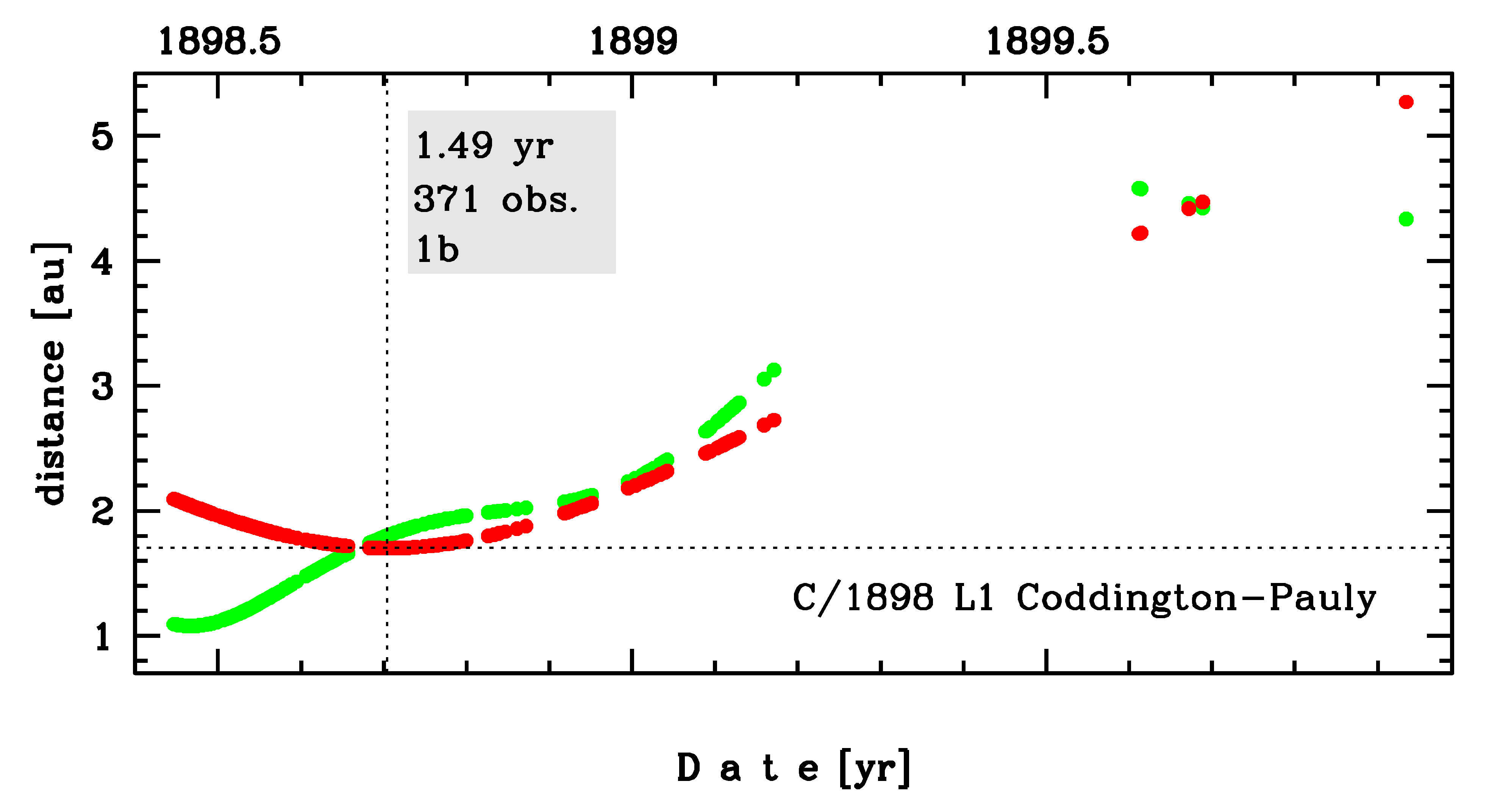C/1898 L1 Coddington-Pauly
more info
C/1898 L1 was discovered on 11 June 1898 by Edwin Foster Coddington at Lick Observatory. Independently, the comet was also found in the evening of 14 June 1898by Wolfgang Pauly in Bucharest, who had no knowledge of this discovery, although the comet was already observed at European observatories previously informed about this event.At the moment of discovery, C/1898 L1 was about 3 months before its perihelion passage and it was last seen on 7 December 1899.
This comet made its closest approach to the Earth on 19 June 1898 (1.079 au), that is a week after its discovery.
Solutions given here are based on data spanning over 1.49 yr in a range of heliocentric distances from 2.09 au through perihelion (1.702 au) to 5.27 au.Two non-gravitational solutions given here differ in how the data was weighted: solution n2 is based on measurements weighted as in the case of pure gravitational orbit determination;while preferred NG solution is obtain in a standard way (dedicated data weighting for non-gravitational orbit determination).
This comet suffers notable planetary perturbations during its passage through the planetary system; these perturbations lead to escape the comet from the planetary zone on hypebolic orbit (see future barycentric orbits).
C/1896 V1 was in the original sample of 19 comets used by Oort for his hypothesis on LPCs; however, according to presented here statistics for previous perihelion passage, this comet seems be dynamically old (see both non-gravitatioal solutions).
See also Królikowska 2020.
This comet made its closest approach to the Earth on 19 June 1898 (1.079 au), that is a week after its discovery.
Solutions given here are based on data spanning over 1.49 yr in a range of heliocentric distances from 2.09 au through perihelion (1.702 au) to 5.27 au.Two non-gravitational solutions given here differ in how the data was weighted: solution n2 is based on measurements weighted as in the case of pure gravitational orbit determination;while preferred NG solution is obtain in a standard way (dedicated data weighting for non-gravitational orbit determination).
This comet suffers notable planetary perturbations during its passage through the planetary system; these perturbations lead to escape the comet from the planetary zone on hypebolic orbit (see future barycentric orbits).
C/1896 V1 was in the original sample of 19 comets used by Oort for his hypothesis on LPCs; however, according to presented here statistics for previous perihelion passage, this comet seems be dynamically old (see both non-gravitatioal solutions).
See also Królikowska 2020.
| solution description | ||
|---|---|---|
| number of observations | 371 | |
| data interval | 1898 06 12 – 1899 12 07 | |
| data type | perihelion within the observation arc (FULL) | |
| data arc selection | entire data set (STD) | |
| range of heliocentric distances | 2.09 au – 1.70 au (perihelion) – 5.27 au | |
| type of model of motion | NS - non-gravitational orbits for standard g(r) | |
| data weighting | YES | |
| number of residuals | 716 | |
| RMS [arcseconds] | 3.02 | |
| orbit quality class | 1b | |
| previous orbit statistics, both Galactic and stellar perturbations were taken into account | ||
|---|---|---|
| no. of returning VCs in the swarm | 4994 | * |
| no. of escaping VCs in the swarm | 7 | |
| no. of hyperbolas among escaping VCs in the swarm | 1 | |
| previous reciprocal semi-major axis [10-6 au-1] | 62.87 – 91.12 – 120.24 | R |
| previous perihelion distance [au] | 1.79 – 1.98 – 2.92 | R |
| previous aphelion distance [103 au] | 17 – 22 – 32 | R |
| time interval to previous perihelion [Myr] | 0.76 – 1.1 – 2 | R |
| percentage of VCs with qprev < 10 | 95 | |
| percentage of VCs with qprev > 20 | 5 | |
| previous_g orbit statistics, here only the Galactic tide has been included | ||
|---|---|---|
| no. of returning VCs in the swarm | 4994 | * |
| no. of escaping VCs in the swarm | 7 | |
| no. of hyperbolas among escaping VCs in the swarm | 0 | |
| previous reciprocal semi-major axis [10-6 au-1] | 62.89 – 91.08 – 120.24 | R |
| previous perihelion distance [au] | 1.79 – 1.94 – 2.7 | R |
| previous aphelion distance [103 au] | 17 – 22 – 32 | R |
| time interval to previous perihelion [Myr] | 0.76 – 1.1 – 2 | R |
| percentage of VCs with qprev < 10 | 99 | |
| percentage of VCs with qprev > 20 | 1 | |
